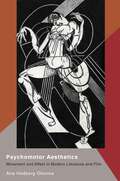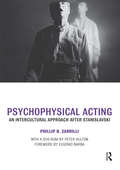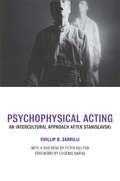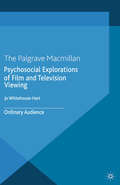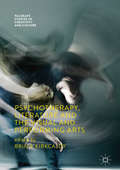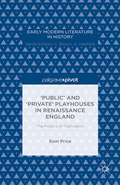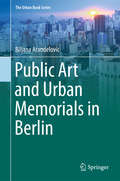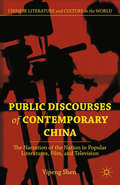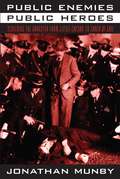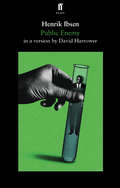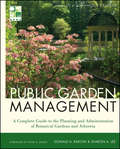- Table View
- List View
PSYCHOMOTOR AESTHETICS C: Movement and Affect in Modern Literature and Film
by Ana Hedberg OleninaIn the late 19th century, modern psychology emerged as a discipline, shaking off metaphysical notions of the soul in favor of a more scientific, neurophysiological concept of the mind. Laboratories began to introduce instruments and procedures which examined bodily markers of psychological experiences, like muscle contractions and changes in vital signs. Along with these changes in the scientific realm came a newfound interest in physiological psychology within the arts - particularly with the new perception of artwork as stimuli, able to induce specific affective experiences. In Psychomotor Aesthetics, author Ana Hedberg Olenina explores the effects of physiological psychology on art at the turn of the 20th century. The book explores its influence on not only art scholars and theorists, wishing to understand the relationship between artistic experience and the internal processes of the mind, but also cultural producers more widely. Actors incorporated psychology into their film acting techniques, the Russian and American film industries started to evaluate audience members' physical reactions, and literary scholars began investigations into poets' and performers' articulation. Yet also looming over this newly emergent field were commercial advertisers and politicians, eager to use psychology to further their own mass appeal and assert control over audiences. Drawing from archival documents and a variety of cross-disciplinary sources, Psychomotor Aesthetics calls attention to the cultural resonance of theories behind emotional and cognitive experience - theories with implications for today's neuroaesthetics and neuromarketing.
Psychophysical Acting: An Intercultural Approach after Stanislavski
by Phillip B. ZarrilliPsychophysical Acting is a direct and vital address to the demands of contemporary theatre on today’s actor. Drawing on over thirty years of intercultural experience, Phillip Zarrilli aims to equip actors with practical and conceptual tools with which to approach their work. Areas of focus include: an historical overview of a psychophysical approach to acting from Stanislavski to the present acting as an ‘energetics’ of performance, applied to a wide range of playwrights: Samuel Beckett, Martin Crimp, Sarah Kane, Kaite O’Reilly and Ota Shogo a system of training though yoga and Asian martial arts that heightens sensory awareness, dynamic energy, and in which body and mind become one practical application of training principles to improvisation exercises. Psychophysical Acting is accompanied by Peter Hulton’s interactive DVD-ROM featuring exercises, production documentation, interviews, and reflection.
Psychophysical Acting: An Intercultural Approach after Stanislavski
by Phillip B. ZarrilliPsychophysical Acting is a direct and vital address to the demands of contemporary theatre on today’s actor. Drawing on over thirty years of intercultural experience, Phillip Zarrilli aims to equip actors with practical and conceptual tools with which to approach their work. Areas of focus include: an historical overview of a psychophysical approach to acting from Stanislavski to the present acting as an ‘energetics’ of performance, applied to a wide range of playwrights: Samuel Beckett, Martin Crimp, Sarah Kane, Kaite O’Reilly and Ota Shogo a system of training though yoga and Asian martial arts that heightens sensory awareness, dynamic energy, and in which body and mind become one practical application of training principles to improvisation exercises. Psychophysical Acting is accompanied by Peter Hulton’s interactive DVD-ROM featuring exercises, production documentation, interviews, and reflection.
The Psychopolitics of Fashion: Conflict and Courage Under the Current State of Fashion
by Otto Von BuschWhat if fashion was a state? What kind of state would it be? Probably not a democracy. Otto von Busch sees fashion as a totalitarian state, with a population all too eager to enact the decrees of its aesthetic superiority. Peers police each other and deploy acts of judgment, peer-regulation, and micro-violence to uphold the aesthetic order of fashion supremacy. Using four design projects as tools for inquiry, Von Busch explores the seductive desires of envy and violence within fashion drawing on political theories. He proposes that the violent conflicts of fashion happen not only in arid cotton fields or collapsing factories, but in the everyday practice of getting dressed, in the judgments, sneers, and rejections of others. Indeed, he suggests that feelings of inclusion and adoration are what make us feel the pleasure of being fashionable-of being seductive, popular, and powerful. Exploring the conflicting emotions associated with fashion, Von Busch argues that while the current state of fashion is bred out of fear, The Psychopolitics of Fashion can offer constructive modes of mitigation and resistance. Through projects that actively work towards disarming the violent practices of dress, Von Busch suggests paths towards a more engaging and meaningful experience of fashion he calls “deep fashion.”
The Psychopolitics of Fashion: Conflict and Courage Under the Current State of Fashion
by Otto Von BuschWhat if fashion was a state? What kind of state would it be? Probably not a democracy. Otto von Busch sees fashion as a totalitarian state, with a population all too eager to enact the decrees of its aesthetic superiority. Peers police each other and deploy acts of judgment, peer-regulation, and micro-violence to uphold the aesthetic order of fashion supremacy. Using four design projects as tools for inquiry, Von Busch explores the seductive desires of envy and violence within fashion drawing on political theories. He proposes that the violent conflicts of fashion happen not only in arid cotton fields or collapsing factories, but in the everyday practice of getting dressed, in the judgments, sneers, and rejections of others. Indeed, he suggests that feelings of inclusion and adoration are what make us feel the pleasure of being fashionable-of being seductive, popular, and powerful. Exploring the conflicting emotions associated with fashion, Von Busch argues that while the current state of fashion is bred out of fear, The Psychopolitics of Fashion can offer constructive modes of mitigation and resistance. Through projects that actively work towards disarming the violent practices of dress, Von Busch suggests paths towards a more engaging and meaningful experience of fashion he calls “deep fashion.”
Psychosocial Explorations of Film and Television Viewing: Ordinary Audience (Studies in the Psychosocial)
by Jo Whitehouse-HartMost people have, at some point, experienced powerful, often strange and disconcerting, responses to films and television programmes of which they cannot always make sense. Drawing on insights from psychoanalysis, this book argues that the seemingly mundane and everyday activity of film and television viewing in the home is in fact extraordinary.
Psychosomatic Imagery: Photographic Reflections on Mental Disorders
by Ali Shobeiri Helen WestgeestThis book explores the potential of specific photographic images for reflecting on experiences of mental disorders. Instead of looking at photographs of (people suffering from) mental disorders, this volume aspires to comprehend the complexities of such conditions through photographic lexicons, metaphors, and practices. For this book, a mental disorder is not to be seen as a dysfunction or impairment, but a state in which the sustaining balance of stable and unstable mind is unsettled, which may induce mental/bodily disturbances. The term “psychosomatic” refers to the interaction of the mind (psyche) with the body (soma); it refers to their co-dependence. By the term “Psychosomatic Imagery” this volume refers to a distinctive trope of photographic images that deal with the body-mind interaction during the states of mental disorders. This novel theoretical framework in photography theory instigates critical discussions about the experiences of mental disorders visualized as disturbed corporeal and mental perceptions of the world. While the introduction of the volume unpacks and assesses the applications of photography in mental disorder studies from theoretical and historical perspectives, the chapters focus on specific cases of Psychosomatic Imagery in contemporary photography. Those cases include, but are not limited to: PTSD, hysteria, paranoia, psychosis, bipolar disorder, and Hikikomori.
Psychotherapy, Literature and the Visual and Performing Arts (Palgrave Studies in Creativity and Culture)
by Bruce KirkcaldyThis book explores the relevance of literature and the performing and visual arts for effective clinical psychotherapy. There is a growing interest in the use of the arts in psychotherapy, in part due to an increasing awareness of the limitations in verbal communication and scepticism towards traditional forms of medical treatment. Gathering together perspectives from international practitioners this volume embraces the value of a range of mediums to psychotherapy, from film and photo-therapy to literature and narrative therapy. Based on theoretical studies, clinical expertise and experiential learning, authors offer detailed guidelines on the value of various art forms in practice.
Psychotherapy, Literature and the Visual and Performing Arts (Palgrave Studies in Creativity and Culture)
by Bruce KirkcaldyThis book explores the relevance of literature and the performing and visual arts for effective clinical psychotherapy. There is a growing interest in the use of the arts in psychotherapy, in part due to an increasing awareness of the limitations in verbal communication and scepticism towards traditional forms of medical treatment. Gathering together perspectives from international practitioners this volume embraces the value of a range of mediums to psychotherapy, from film and photo-therapy to literature and narrative therapy. Based on theoretical studies, clinical expertise and experiential learning, authors offer detailed guidelines on the value of various art forms in practice.
Public Administration for Planners: Leadership and Responsibility in Theory and Practice
by Stephen KehsThis book offers an introduction to public administration by a veteran practitioner, written for planners, as well as students seeking a public administration career and individuals simply wanting to learn more about responsible government. The narrative provides an overview of public administration theory and the importance of leadership in today’s contentious political environment. The book contains five parts including an introduction, parts on management, the public sector and government programs, and some impressions on why this subject is so critically important in our society today. Typical administrative responsibilities are addressed as well as issues not typically covered in books on public administration, along with observations about sound public administration. Each part also contains practical exercises, discussion questions and references to other texts and academic resources. Because public administration is fundamentally about relationships with people and communities, the book provides lessons that can be applied easily to one’s personal life and experiences. It is a timely narrative on public administration today that will be valuable reading for planners and planning students looking to better understand public administration and policy.
Public Administration for Planners: Leadership and Responsibility in Theory and Practice
by Stephen KehsThis book offers an introduction to public administration by a veteran practitioner, written for planners, as well as students seeking a public administration career and individuals simply wanting to learn more about responsible government. The narrative provides an overview of public administration theory and the importance of leadership in today’s contentious political environment. The book contains five parts including an introduction, parts on management, the public sector and government programs, and some impressions on why this subject is so critically important in our society today. Typical administrative responsibilities are addressed as well as issues not typically covered in books on public administration, along with observations about sound public administration. Each part also contains practical exercises, discussion questions and references to other texts and academic resources. Because public administration is fundamentally about relationships with people and communities, the book provides lessons that can be applied easily to one’s personal life and experiences. It is a timely narrative on public administration today that will be valuable reading for planners and planning students looking to better understand public administration and policy.
‘Public’ and ‘Private’ Playhouses in Renaissance England: The Politics Of Publication (Early Modern Literature in History)
by Eoin PriceAt the start of the seventeenth century a distinction emerged between 'public', outdoor, amphitheatre playhouses and 'private', indoor, hall venues. This book is the first sustained attempt to ask: why? Theatre historians have long acknowledged these terms, but have failed to attest to their variety and complexity. Assessing a range of evidence, from the start of the Elizabethan period to the beginning of the Restoration, the book overturns received scholarly wisdom to reach new insights into the politics of theatre culture and playbook publication. Standard accounts of the 'public' and 'private' theatres have either ignored the terms, or offered insubstantial explanations for their use. This book opens up the rich range of meanings made available by these vitally important terms and offers a fresh perspective on the way dramatists, theatre owners, booksellers, and legislators, conceived the playhouses of Renaissance London.
Public and Private Spaces of the City
by Ali MadanipourThe relationship between public and private spheres is one of the key concerns of the modern society. This book investigates this relationship, especially as manifested in the urban space with its social and psychological significance. Through theoretical and historical examination, it explores how and why the space of human socities is subdivided into public and private sections. It starts with the private, interior space of the mind and moves step by step, through the body, home, neighborhood and the city, outwards to the most public, impersonal spaces, exploring the nature of each realm and their complex, interdependent realtionships.A stimulating and thought provoking book for any architect, architectural historian, urban planner or designer.
Public and Private Spaces of the City
by Ali MadanipourThe relationship between public and private spheres is one of the key concerns of the modern society. This book investigates this relationship, especially as manifested in the urban space with its social and psychological significance. Through theoretical and historical examination, it explores how and why the space of human socities is subdivided into public and private sections. It starts with the private, interior space of the mind and moves step by step, through the body, home, neighborhood and the city, outwards to the most public, impersonal spaces, exploring the nature of each realm and their complex, interdependent realtionships.A stimulating and thought provoking book for any architect, architectural historian, urban planner or designer.
Public Art and Museums in Cultural Districts (Routledge Research in Museum Studies)
by J. Pedro LorenteMuseums and public art have traditionally taken significantly different approaches to customer engagement, but throughout history they have also worked together in some urban contexts, notably as landmarks of so-called cultural districts. Public Art and Museums in Cultural Districts reviews their changing interactions in many different types of cities since the Enlightenment, or even before, going back to the etymological origins of museums and monuments in classical antiquity. The type of historical enquiry presented within the volume is not intended as a total narrative, but the international study cases considered convey a global panorama of the shifting paradigms set in different periods by some cultural neighbourhoods and emulated worldwide. Blurring boundaries between art history, museology and urbanism, this critical account explores past tensions, achievements and failures, giving insightful consideration to present policies and pointing out reasonable recommendations for the future regarding public heritage. Presenting for the first time an insights into the role of collections of public art as landmarks of cultural districts, this book considers collections displayed outdoors from the double perspective of curatorial outreach and civic values. This book will fill a gap in the existing museum studies literature, hitherto mainly focused on indoor collecting and curatorial policies, but increasingly more and more attentive to their outside context. As such, the book should be of great interest to academics, researchers and students working in the fields of art, heritage, museum studies and urban history. It should also be of value to professionals working in the museum and art sectors.
Public Art and Museums in Cultural Districts (Routledge Research in Museum Studies)
by J. Pedro LorenteMuseums and public art have traditionally taken significantly different approaches to customer engagement, but throughout history they have also worked together in some urban contexts, notably as landmarks of so-called cultural districts. Public Art and Museums in Cultural Districts reviews their changing interactions in many different types of cities since the Enlightenment, or even before, going back to the etymological origins of museums and monuments in classical antiquity. The type of historical enquiry presented within the volume is not intended as a total narrative, but the international study cases considered convey a global panorama of the shifting paradigms set in different periods by some cultural neighbourhoods and emulated worldwide. Blurring boundaries between art history, museology and urbanism, this critical account explores past tensions, achievements and failures, giving insightful consideration to present policies and pointing out reasonable recommendations for the future regarding public heritage. Presenting for the first time an insights into the role of collections of public art as landmarks of cultural districts, this book considers collections displayed outdoors from the double perspective of curatorial outreach and civic values. This book will fill a gap in the existing museum studies literature, hitherto mainly focused on indoor collecting and curatorial policies, but increasingly more and more attentive to their outside context. As such, the book should be of great interest to academics, researchers and students working in the fields of art, heritage, museum studies and urban history. It should also be of value to professionals working in the museum and art sectors.
Public Art and Urban Memorials in Berlin (The Urban Book Series)
by Biljana ArandelovicThis book provides insight into the significant area of public art and memorials in Berlin. Through diverse selected examples, grouped according to their basic character and significance, the most important art projects produced in the period since World War II are presented and discussed. Both as a critical theoretical work and rich photo book, this volume is a unique selection of Berlin’s diverse visual elements, contemporary and from the recent past. Some artworks are very famous and are already symbols of Berlin while others are less well known. Public Art and Urban Memorials in Berlin analyzes the connections created by public art on one hand, and urban space and architectural forms on the other.This volume considers the Berlin works of iconic artists such as Christo and Jeanne-Claude, Daniel Libeskind, Dani Karavan, Bernar Venet, Keith Haring, Christian Boltanski, Richard Serra, Peter Eisenman, Henry Moore, Claes Oldenburg and Coosje van Brüggen, Wolf Vostell, Gerhard Richter, Eduardo Chillida, Jonathan Borofsky, Olaf Metzel, Sol LeWitt, Frank Gehry, Max Lingner, Bernhard Heiliger, Frank Thiel, Juan Garaizabal and more. The reader is led through seven chapters: Creative City Berlin, Introduction to Public Art, Public Art in Berlin, the Celebration of Berlin’s 750th Anniversary in 1987, Temporary public art, Socialist Realism in Art, and Urban Memorials. The chapter Public Art in Berlin discusses selected projects, Bundestag Public Art Collection, Public Art at Potsdamer Platz and The City and the river – a renewed relationship. The chapter on urban memorials discusses: Remembering the Divided City and Holocaust Memorials in Berlin. The book delivers nine interviews with artists whose Berlin work is revealed through this volume (Bernar Venet, Hubertus von der Goltz, Dani Karavan, Juan Garaizabal, Susanne Lorenz, Kalliopi Lemos, Frank Thiel, Karla Sachse and Nikolaus Koliusis).
Public Discourses of Contemporary China: The Narration of the Nation in Popular Literatures, Film, and Television (Chinese Literature and Culture in the World)
by Y. ShenAnalyzing contemporary Chinese literature, film, and television, Shen shows the significance of nationalism for the mass imagination in post-socialist China. Chapters move from the intellectual idealism of the 1980s, through the post-Tiananmen transition, to the national cinema of the 1990s, and finally to the Internet literature of today.
Public Enemies, Public Heroes: Screening the Gangster from Little Caesar to Touch of Evil
by Jonathan MunbyIn this study of Hollywood gangster films, Jonathan Munby examines their controversial content and how it was subjected to continual moral and political censure. Beginning in the early 1930s, these films told compelling stories about ethnic urban lower-class desires to "make it" in an America dominated by Anglo-Saxon Protestant ideals and devastated by the Great Depression. By the late 1940s, however, their focus shifted to the problems of a culture maladjusting to a new peacetime sociopolitical order governed by corporate capitalism. The gangster no longer challenged the establishment; the issue was not "making it," but simply "making do." Combining film analysis with archival material from the Production Code Administration (Hollywood's self-censoring authority), Munby shows how the industry circumvented censure, and how its altered gangsters (influenced by European filmmakers) fueled the infamous inquisitions of Hollywood in the postwar '40s and '50s by the House Committee on Un-American Activities. Ultimately, this provocative study suggests that we rethink our ideas about crime and violence in depictions of Americans fighting against the status quo.
Public Enemy
by Henrik IbsenWhen Dr. Stockmann discovers that the waters of a new public spa are toxic, he expects gratitude and glory. Instead, his revelation makes him the most hated man in town.Henrik Ibsen's timeless story of corruption, pollution and courage opened in David Harrower's powerful new version at the Young Vic, London, in May 2013.
Public Engagement Made Easy: A Guide for Planners and Policymakers
by Susan CharlandLocal leaders don’t need to become professional facilitators or hire expensive consultants to run a great meeting. Public Engagement Made Easy offers practical and affordable methods that bring ease to one of the most challenging aspects of any local leader’s role: involving the public. The tools and techniques in this book will empower planners, public managers, decision-makers, and other leaders to implement effective public engagement programs that build trust within communities and contribute to successful decisions that stand the test of time.
Public Engagement Made Easy: A Guide for Planners and Policymakers
by Susan CharlandLocal leaders don’t need to become professional facilitators or hire expensive consultants to run a great meeting. Public Engagement Made Easy offers practical and affordable methods that bring ease to one of the most challenging aspects of any local leader’s role: involving the public. The tools and techniques in this book will empower planners, public managers, decision-makers, and other leaders to implement effective public engagement programs that build trust within communities and contribute to successful decisions that stand the test of time.
Public Garden Management: A Complete Guide to the Planning and Administration of Botanical Gardens and Arboreta
by Donald Rakow Sharon LeeThe complete-and-ready reference for establishing, managing, and running a successful and sustainable, profitable public garden As unique museums with living collections of plants, public gardens offer visitors aesthetically beautiful landscapes combined with educational programming and scientific research that promote the value and understanding of plants. In the twenty-first century, public gardens are in the forefront of organizations and institutions committed to promoting the conservation of plants and their habitats, developing sustainable practices that support the environment, and providing green spaces where our increasingly stressed and urbanized citizens can reconnect with the natural world. It is critically important that such institutions have trained, knowledgeable staff members. Because of its comprehensive examination of public gardens, Public Garden Management is the ideal guide for staff members at public gardens, anyone considering a career in public gardens, groups starting a botanical garden or arboretum, and students discovering how these complex institutions work. Public Garden Management is an all-in-one professional reference and textbook that clearly shows how to develop, establish, manage, and maintain a sustainable—both economically and environmentally—public garden. Offering practical coverage of relevant topics, along with useful tools for reinforcing study, this insightful and forward-thinking guide is: Copublished by the American Public Gardens Association Written by a panel of leading experts in the field Filled with dozens of case studies that are real-world illustrations of the principles explored in the text Illustrated throughout with line drawings, figures, and photographs that assist in conveying critical information Students and professionals will benefit greatly from the management principles outlined in this book, helping them establish and maintain new and existing public gardens that engage, inspire, and connect with their communities.
Public Garden Management: A Complete Guide to the Planning and Administration of Botanical Gardens and Arboreta
by Donald Rakow Sharon LeeThe complete-and-ready reference for establishing, managing, and running a successful and sustainable, profitable public garden As unique museums with living collections of plants, public gardens offer visitors aesthetically beautiful landscapes combined with educational programming and scientific research that promote the value and understanding of plants. In the twenty-first century, public gardens are in the forefront of organizations and institutions committed to promoting the conservation of plants and their habitats, developing sustainable practices that support the environment, and providing green spaces where our increasingly stressed and urbanized citizens can reconnect with the natural world. It is critically important that such institutions have trained, knowledgeable staff members. Because of its comprehensive examination of public gardens, Public Garden Management is the ideal guide for staff members at public gardens, anyone considering a career in public gardens, groups starting a botanical garden or arboretum, and students discovering how these complex institutions work. Public Garden Management is an all-in-one professional reference and textbook that clearly shows how to develop, establish, manage, and maintain a sustainable—both economically and environmentally—public garden. Offering practical coverage of relevant topics, along with useful tools for reinforcing study, this insightful and forward-thinking guide is: Copublished by the American Public Gardens Association Written by a panel of leading experts in the field Filled with dozens of case studies that are real-world illustrations of the principles explored in the text Illustrated throughout with line drawings, figures, and photographs that assist in conveying critical information Students and professionals will benefit greatly from the management principles outlined in this book, helping them establish and maintain new and existing public gardens that engage, inspire, and connect with their communities.
Public History: A Practical Guide
by Faye SayerPublic History: A Practical Guide explores history in the public sphere and examines the variety of skills that historians require in the practice of public history. It discusses how through various mediums of interpretation and presentation a range of actors, which include museums, archives, government agencies, community history societies and the media and digital media, make history accessible to a wider audience. It provides the reader with an overview of the wider-world application and communication of history beyond the classroom through core case studies for each sector that include ideas for best practice 'in the field'.This book offers an accessible and engaging synopsis of a topic that has not previously been covered. By focusing on an area of study that has changed substantially in the last decade, Public History: A Practical Guide presents a comprehensive outline of the practice of 'public history', and provides ideas for future methodological approaches as well as a reference point for planning professional development in order to gain future employment in these sectors.In the current economic climate, students need to understand the potential use of history beyond university; this book contains the tools and advice needed for them to get one step ahead in terms of knowledge, skills and experience.
